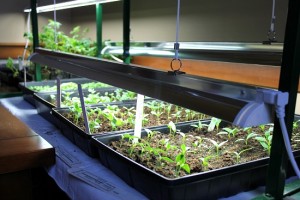
Some of the most productive for cloning and vegetative growth that are used by growers are fluorescent grow lights and growers even use these lights to flower their gardens.
These lighting systems use long glass tube lights that you can use different spectrum bulbs. These systems allow you to use a single light spectrum bulb in the fixture or mix and match different spectrum bulbs for marijuana grow lights.
The light spectrum produced by these bulbs is almost identical to natural sunlight. These grow lights work very well for seedlings and clones.
They supply the necessary lighting spectrum to the plants while maintaining a cool running temperature. Fluorescent lamps produce less lumen output than HID lights but can be placed closer to your plants for increased growth and better results.
These grow lights will take a few seconds to a minute to warm up and become fully illuminated. Fluorescent lights create light by passing electricity through the gaseous vapor that is under low pressure.
These grow lights require a ballast to regulate electricity and bulb function so these ballasts are built into the lighting fixture. Some people try to grow cannabis using fluorescent fixtures with black lights that emit ultraviolet (UV) rays, this does not work so save your money and time by purchasing the right marijuana grow lights.
Fluorescent lamps come in a wide variety of hood designs with various bulb sizes, wattages, and lumen outputs. The sizes of fluorescent bulbs used in these systems are the T-5s, T-8s, and T-12s, but T-5s are the most common marijuana grow lights.
These bulbs can come in lengths of 2 – 4 feet. Many times the ballasts on these lighting systems will last for 10 – 12 years though bulbs will need to be replaced more often – at about 20,000 hours of use.
“T” Is Tubular For Fluorescent Lights
The letter ‘T’ in the lighting industry stands for “tubular,” this makes sense when one considers that fluorescent tubes are tubular. The number directly following the letter “T” indicates the thickness or diameter of that particular tube in eighths of an inch (1/8 inch).
- T-12: Twelve-eighths of an inch in diameter or 1 1/2 inches thick.
- T-8: Eight-eighths of an inch in diameter or 1 inch thick.
- T-5: Five-eighths of an inch in diameter or five-eighths of an inch thick
As energy saving has become popular the codes on fluorescent lighting bulbs and systems designate the levels of energy efficiency instead of merely indicating the lamp tube diameter.

Marijuana Grow Lights’ Efficiency
- T12 – Old $ Inefficient
- T8 – Higher Efficiency
- T5 – Highest Efficiency
Although these assumptions are generally true, it is important to look at the application and determine the cost-benefit of T-5s over T-8s to determine if the increased efficiency of T-5 justifies the increase in costs.
Though T-5 fixtures and bulbs cost more than T-8 fixtures and bulbs, if you are purchasing T-5 High Output (HO) bulbs the lighting will almost be double that of a normal T-8. All in all, there is a very close battle in efficiency and lighting between T-5s and T-8s. The average lumen output for fluorescent bulbs varies from one manufacturer to another.
A 40-watt T-12 will usually be around 2,800 lumens-per-bulb and roughly 68 lumens-per-watt. A 32-watt T-8 will usually be around 3,200 lumens per bulb that are about 100 lumens-per-watt and a 54-watt, as well as T-5 High Output (HO) bulb, will produce around 5,000 lumens per bulb with about 92 lumens-per-watt.
These bulbs will emanate either a warm (3,000 K) or cool (5,000 – 6,500 K) light. T12s are rarely if ever, used for marijuana grow lights since they are not as efficient as T-5s or T-8s.
Let us know what you think.




Responses